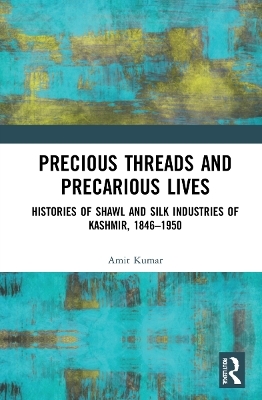
Precious Threads and Precarious Lives
Histories of Shawl and Silk Industries of Kashmir, 1846–1950
Seiten
2024
Routledge India (Verlag)
978-1-032-00137-1 (ISBN)
Routledge India (Verlag)
978-1-032-00137-1 (ISBN)
This book studies the hitherto unexplored history of the shawl and silk industries of Kashmir, India.
This book studies the hitherto unexplored history of the shawl and silk industries of the himalyan state of Jammu and Kashmir, India. It focuses on the three processes – production, circulation, and consumption – of the textile industry of the region to highlight its socio-economic and political importance in 19th- and 20th-century Kashmir. Using the micro-history approach, it studies the sites of production – the home looms or the small karkhana – efficiency of labour, and innovations by weavers in their techniques to suit the demands of the market. It also locates the impact colonialism had on transforming the labour economy in the Kashmir textile industry. Further, it compares these karkhanas with the Scottish factories or home looms to illuminate many sites of difference and comparison between the working styles and technologies.
Mapping a history as complex as the weave on the finest Kashmiri shawl, this book brings to life the interface between culture, commodity, and colonial networks. It will be of great interest to scholars and researchers of South Asian history, colonial and imperial history, cultural studies, and economic and labour history.
This book studies the hitherto unexplored history of the shawl and silk industries of the himalyan state of Jammu and Kashmir, India. It focuses on the three processes – production, circulation, and consumption – of the textile industry of the region to highlight its socio-economic and political importance in 19th- and 20th-century Kashmir. Using the micro-history approach, it studies the sites of production – the home looms or the small karkhana – efficiency of labour, and innovations by weavers in their techniques to suit the demands of the market. It also locates the impact colonialism had on transforming the labour economy in the Kashmir textile industry. Further, it compares these karkhanas with the Scottish factories or home looms to illuminate many sites of difference and comparison between the working styles and technologies.
Mapping a history as complex as the weave on the finest Kashmiri shawl, this book brings to life the interface between culture, commodity, and colonial networks. It will be of great interest to scholars and researchers of South Asian history, colonial and imperial history, cultural studies, and economic and labour history.
Amit Kumar is Assistant Professor of History at School of Arts and Sciences, Azim Premji University, Bangalore, India
List of figures
Acknowledgements
Glossary
Introduction
1 Present historiography and its critique
2 Kashmiri shawls and their history
3 Shawl-wool trade and the creation of Jammu and Kashmir, 1819–1846
4 De-industrialisation, globalisation, and the crafts
5 Silk industry of Kashmir
6 Identity of the textile artisans
7 The Resilient Artisan: Weavers’ exploitation and resistance
Conclusion
Bibliography
Index
| Erscheinungsdatum | 05.07.2022 |
|---|---|
| Zusatzinfo | 3 Tables, black and white; 7 Line drawings, black and white; 9 Halftones, black and white; 16 Illustrations, black and white |
| Verlagsort | London |
| Sprache | englisch |
| Maße | 156 x 234 mm |
| Gewicht | 453 g |
| Themenwelt | Geisteswissenschaften ► Geschichte ► Regional- / Ländergeschichte |
| Geschichte ► Teilgebiete der Geschichte ► Wirtschaftsgeschichte | |
| Naturwissenschaften ► Geowissenschaften ► Geografie / Kartografie | |
| Sozialwissenschaften ► Soziologie ► Spezielle Soziologien | |
| ISBN-10 | 1-032-00137-2 / 1032001372 |
| ISBN-13 | 978-1-032-00137-1 / 9781032001371 |
| Zustand | Neuware |
| Haben Sie eine Frage zum Produkt? |
Mehr entdecken
aus dem Bereich
aus dem Bereich


